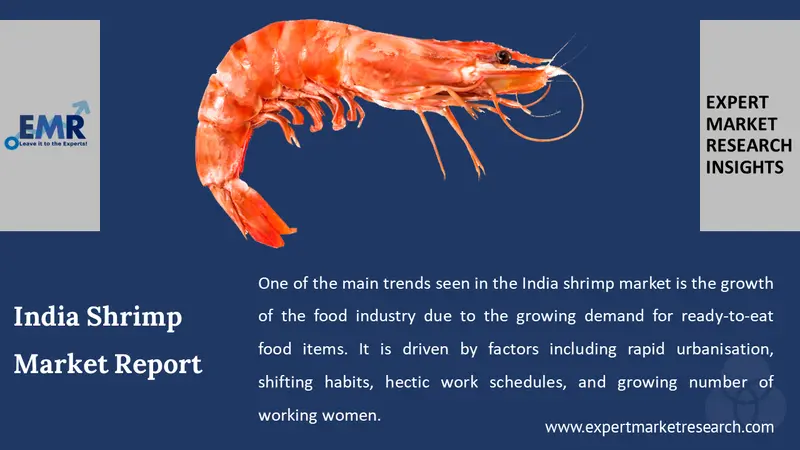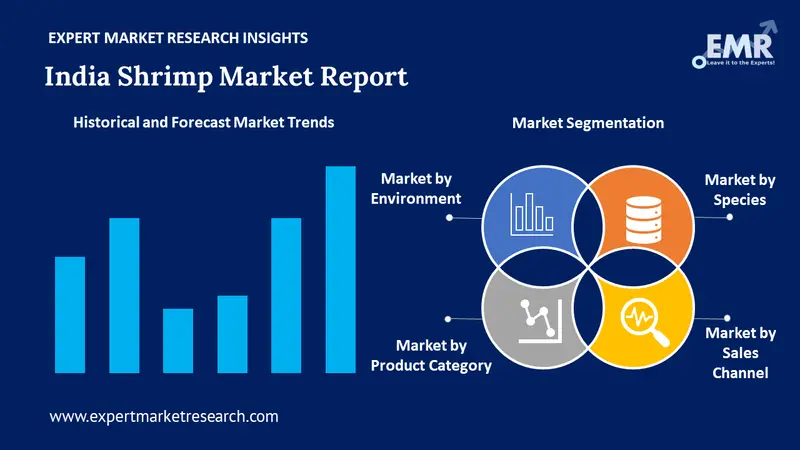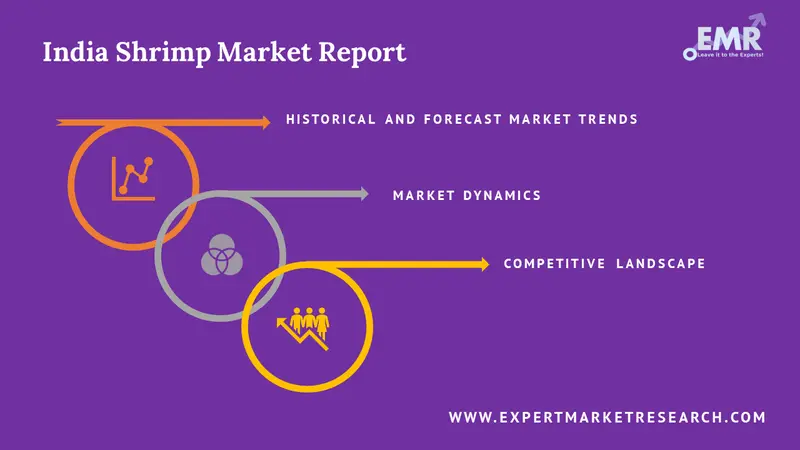
Consumer Insights
Uncover trends and behaviors shaping consumer choices today
Procurement Insights
Optimize your sourcing strategy with key market data
Industry Stats
Stay ahead with the latest trends and market analysis.
The India shrimp market reached a volume of 1.02 MMT in 2025. The market is further expected to grow at a CAGR of 9.60% in the forecast period of 2026-2035, reaching a volume of approximately 2.55 MMT by 2035.
Base Year
Historical Period
Forecast Period
Compound Annual Growth Rate
9.6%
Value in MMT
2026-2035
*this image is indicative*
| India Shrimp Market Report Summary | Description | Value |
| Base Year | MMT | 2025 |
| Historical Period | MMT | 2019-2025 |
| Forecast Period | MMT | 2026-2035 |
| Market Size 2025 | MMT | 1.02 |
| Market Size 2035 | MMT | 2.55 |
| CAGR 2019-2025 | Percentage | XX% |
| CAGR 2026-2035 | Percentage | 9.60% |
| CAGR 2026-2035 - Market by Region | West India | 10.9% |
| CAGR 2026-2035 - Market by Type | Farming | 11.0% |
| CAGR 2026-2035 - Market by End Use | Peeled | 11.3% |
| Market Share by Region | West India | 28.5% |
In India, fisheries is a significant economic sector and offers vast opportunities for development. This is attributed to the diverse resources and potential of the country. andhra pradesh is the leading shrimp producer, accounting for more than 50% of the total output, which contributes to the growth of India shrimp market.
The Indian Government is promoting sustainable shrimp farming practices to produce high-quality 'sustainable' shrimp in order to minimise the environmental effects of shrimp aquaculture. Moreover, the Seafood Exporters Association of India (SEAI) and the Marine Products Export Development Authority (MPEDA) are supporting the export of shrimp, especially for ready-to-eat and ready-to-cook products.

Read more about this report - REQUEST FREE SAMPLE COPY IN PDF
There is a growing emphasis on sustainable shrimp farming practices to meet international certification standards, such as Best Aquaculture Practices (BAP) and Aquaculture Stewardship Council (ASC). Producers are increasingly investing in technology for traceability, especially in export markets, as consumers demand more information on sourcing, sustainability, and quality. These are the major trends in India shrimp market.
The domestic shrimp market has grown, though the international market remains critical for sustaining prices. As a key export player, India benefits from Ecuador's current supply disruptions due to energy rationing, which could potentially redirect global buyers towards Indian shrimp. This shift is anticipated to strengthen prices in the Indian market for value-added shrimp products as well as strengthen current status of shrimp farming in India.
Easy availability of shrimp and its high nutritional content are the main growth-inducing factors. They are an essential part of the different cuisines being one of the most traded species of seafood. With the growing demand for disease-free and stable shrimp, India has become one of the largest exporters of shrimp to the United States and the European Union. One of the main trends increasing shrimp consumption in India is the growth of the food industry due to the growing demand for ready-to-eat food items. It is driven by factors including rapid urbanisation, shifting habits, hectic work schedules, and growing number of working women. As a result, the shrimp market in India is experiencing healthy production. In addition, the growing demand for shrimp globally has positively affected imports of shrimp from India. Moreover, the growing consumer health consciousness, rising disposable incomes, and improving living standards remain some of the other primary factors that are further increasing the demand for shrimps in India.
Rising Production and Exports of Shrimps
From 2020 to May 2024, the number of shrimp ponds in Central and Northern Andhra Pradesh has exhibited steady growth. As per the India shrimp industry analysis, the total number of shrimp ponds across both regions grew from 80,435 in 2020 to 91,800 in May 2024. In Central Andhra Pradesh, the number of shrimp ponds increased from 53,890 in 2020 to 63,184 in May 2024. This represents a significant growth trend, with a notable jump between 2023 and May 2024, where the number increased from 58,520 to 63,184. The annual increases indicate consistent investment and expansion in shrimp farming infrastructure in this region. In Northern Andhra Pradesh, the number of shrimp ponds rose from 26,545 in 2020 to 28,616 in May 2024. Although the growth is more modest compared to Central Andhra Pradesh, there is a clear upward trend. The incremental increases each year suggest a stable but steady expansion of shrimp farming capacity in the northern region.
According to the data of the Ministry of Commerce 2022-2023 year-on-year growth of the export volume for shrimp, in the first five months of 2023 in India exhibited mixed trends, which also boosted the growth of the India shrimp industry. Raw L. vannamei experienced moderate growth at the beginning of the year, with increases of 16% in January, 21% in February, and 23% in March. However, it faced a decline of 12% in April and 10% in May, resulting in an overall year-to-date growth of 4%, totaling 201,242 metric tons (MT).
Raw P. monodon displayed a substantial surge in exports, with remarkable year-on-year growth figures of 89% in January, 106% in February, a significant 336% in March, 178% in April, and 124% in May. This category recorded a 157% increase over the first five months of 2023 over 2022, amounting to 10,586 MT, which further increased the India shrimp industry revenue. Value-added shrimp exports faced consistent declines throughout the period, with decreases of 15% in January, 27% in February, March, and April, and 23% in May. The cumulative decline was 26%, totaling 21,702 MT for the period. Wild shrimp exports also saw a downward trend, with a 15% decrease in January, 21% in February, 14% in March, 36% in April, and 16% in May. This resulted in an overall 20% reduction, amounting to 24,262 MT. The total shrimp exports for the period remained flat, showing no growth compared to the previous year, with the total export volume reaching 257,793 MT.

Read more about this report - REQUEST FREE SAMPLE COPY IN PDF
Shrimp are invertebrate marine animal having an elongated body that is often used as a food product. This is considered a nutritious since it includes proteins, selenium, vitamins, phosphorous, magnesium, copper, iron, and vitamin B12. Many of the health benefits associated with shrimp consumption are weight loss, age management, better bone strength, reduced menstrual pain, and the prevention of cardiovascular diseases.
By environment, the India shrimp market is bifurcated into:
Based on species, the India shrimp market has been segmented into:
On the basis of product category, the India shrimp market is divided into:
Based on sales channel, the India shrimp market is segmented into:
Based on region, the India shrimp market has been segmented into:
| CAGR 2026-2035 - Market by | Type |
| Farming | 11.0% |
| Processing | XX% |
| CAGR 2026-2035 - Market by | End Use |
| Peeled | 11.3% |
| Cooked | 10.8% |
| Shell-on | XX% |
| Breaded | XX% |
| Others | XX% |
| CAGR 2026-2035 - Market by | Region |
| West India | 10.9% |
| East and Central India | 10.2% |
| North India | XX% |
| South India | XX% |
| Market Share by | Region |
| West India | 28.5% |
| South India | XX% |
| North India | XX% |
| East and Central India | XX% |
West India is expected to grow at a CAGR of 10.9% in the forecast period. West India, particularly in Gujarat and Maharashtra, has an extensive coastline and strong infrastructure that supports shrimp farming and indicates a positive trend in state-wise shrimp production in India. The region has invested in ports, cold storage, and processing facilities, enabling efficient production and export logistics. This infrastructure is crucial for handling shrimp volumes, particularly with the rising demand for Indian shrimp in global markets like the U.S. and Europe.

Read more about this report - REQUEST FREE SAMPLE COPY IN PDF
The report gives a detailed analysis of the major shrimp companies in India, covering their competitive landscape, capacity, and latest developments like mergers, acquisitions, and investments, expansions of capacity, and plant turnarounds:
Devi Seafoods Ltd.
Apex Frozen Foods Ltd.
BMR Group
United States Shrimp Market
India Shrimp Feed Market
Europe Shrimp Market
Shrimp Feed Market
Shrimp Market
India Shrimp Hatchery Market Trends
India Value-Added Shrimp Market Trends
Shrimp Disease Management In India




*While we strive to always give you current and accurate information, the numbers depicted on the website are indicative and may differ from the actual numbers in the main report. At Expert Market Research, we aim to bring you the latest insights and trends in the market. Using our analyses and forecasts, stakeholders can understand the market dynamics, navigate challenges, and capitalize on opportunities to make data-driven strategic decisions.*
Get in touch with us for a customized solution tailored to your unique requirements and save upto 35%!
The India shrimp market attained a volume of 1.02 MMT in 2025.
The market is further expected to grow at a CAGR of 9.60% in the forecast period of 2026-2035.
The market is estimated to witness a healthy growth in the forecast period of 2026-2035 to reach around 2.55 MMT by 2035.
The major drivers of the market are rising disposable incomes, increasing population, growing demand for convenient and ready-to-eat food, changing lifestyles, and increasing availability of shrimp.
Governmental support for sustainable shrimp farming, surging health consciousness, and rising exports of shrimp are expected to be the major trends driving the growth of the market.
The major states in the market are Andhra Pradesh, West Bengal, and Gujarat, among others.
The significant species of shrimp in the market are Penaeus Vannamei and Penaeus Monodon, among others.
Key players are Nekkanti Sea Foods Limited, Devi Sea Foods Ltd, BMR Group, Jayalakshmi Sea Foods Pvt. Ltd., SSF Limited, Apex Frozen Foods Ltd., Megaa Moda Private Limited (MMPL), Zeal Aqua Limited, Coastal Corporation Limited, and BKV Industries Limited, among others.
Inadequate cold storage, transportation infrastructure and Frequent outbreaks of diseases such as White Spot Syndrome Virus (WSSV) are major challenges.
Expansion into value-added shrimp products such as ready-to-eat meals can tap into the growing convenience food market.
Key regions in the market are North India, East and Central India, West India and South India.
Explore our key highlights of the report and gain a concise overview of key findings, trends, and actionable insights that will empower your strategic decisions.
| REPORT FEATURES | DETAILS |
| Base Year | 2025 |
| Historical Period | 2019-2025 |
| Forecast Period | 2026-2035 |
| Scope of the Report |
Historical and Forecast Trends, Industry Drivers and Constraints, Historical and Forecast Market Analysis by Segment:
|
| Breakup by Environment |
|
| Breakup by Species |
|
| Breakup by Product Category |
|
| Breakup by Sales Channel |
|
| Breakup by Region |
|
| Market Dynamics |
|
| Competitive Landscape |
|
| Companies Covered |
|
Single User License
One User
USD 3,999
USD 3,599
tax inclusive*
Datasheet
One User
USD 2,499
USD 2,249
tax inclusive*
Five User License
Five User
USD 4,999
USD 4,249
tax inclusive*
Corporate License
Unlimited Users
USD 5,999
USD 5,099
tax inclusive*
*Please note that the prices mentioned below are starting prices for each bundle type. Kindly contact our team for further details.*
Flash Bundle
Small Business Bundle
Growth Bundle
Enterprise Bundle
*Please note that the prices mentioned below are starting prices for each bundle type. Kindly contact our team for further details.*
Flash Bundle
Number of Reports: 3
20%
tax inclusive*
Small Business Bundle
Number of Reports: 5
25%
tax inclusive*
Growth Bundle
Number of Reports: 8
30%
tax inclusive*
Enterprise Bundle
Number of Reports: 10
35%
tax inclusive*
How To Order

Select License Type
Choose the right license for your needs and access rights.

Click on ‘Buy Now’
Add the report to your cart with one click and proceed to register.

Select Mode of Payment
Choose a payment option for a secure checkout. You will be redirected accordingly.
Gain insights to stay ahead and seize opportunities.

Get insights & trends for a competitive edge.

Track prices with detailed trend reports.

Analyse trade data for supply chain insights.

Leverage cost reports for smart savings

Enhance supply chain with partnerships.

Connect For More Information
Our expert team of analysts will offer full support and resolve any queries regarding the report, before and after the purchase.
Our expert team of analysts will offer full support and resolve any queries regarding the report, before and after the purchase.
We employ meticulous research methods, blending advanced analytics and expert insights to deliver accurate, actionable industry intelligence, staying ahead of competitors.
Our skilled analysts offer unparalleled competitive advantage with detailed insights on current and emerging markets, ensuring your strategic edge.
We offer an in-depth yet simplified presentation of industry insights and analysis to meet your specific requirements effectively.
Share